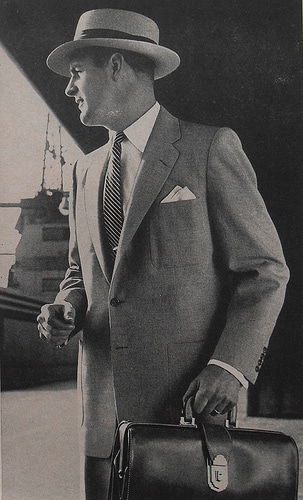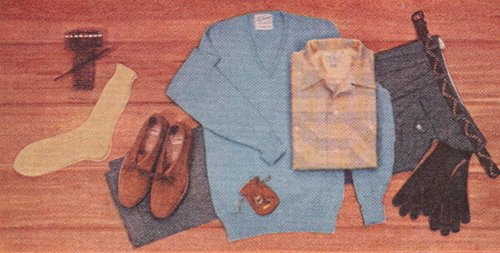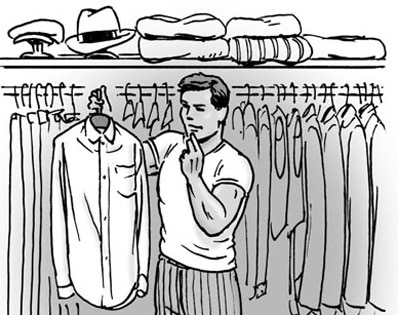
Looking great is easy when you have unlimited resources.
However, most of us live within limited means where every dollar is accounted for.
So how do you build a wardrobe that serves both your professional and personal needs without breaking the bank?
What can Average Joe do to look sharp without investing big bucks in clothing?
Here are ten of my favorite tips for upgrading your style and your wardrobe on a budget.
1. Know Your Thrift Stores
Get to the thrift store.
Second-hand, charity, consignment, and other used clothing stores can be a gold mine for sharp-looking menswear. If you’re patient and thorough, you can find everything from a conservative-looking business suit to funky concert clothes.
But to really make thrift stores work, you’ve got to be a habitual browser. The odds of walking out with something that fits and looks good on any one trip are vanishingly small. It takes multiple trips and an open mind to start building a wardrobe from thrift stores.
Ideally, you should get to know the selection and staff at the closest thrift stores, checking in several times a week for a while until you get a sense for when the new stuff comes out and who to ask about any goodies hidden away in the corners. If you can’t make that many trips, get as many as you can in, and shop with an eye for anything that could look good on you, not just whatever your need of the moment happens to be.
Finally, if you can travel, take an occasional trip out to more distant thrift stores. Ones close to well-heeled suburbs often have a much better selection of upscale clothes than urban stores, and are less picked over as well.
2. Know Your Shoe Re-crafting and Restoration Options
 A nice pair of leather shoes is an instant upgrade to any outfit. It’s one of the simplest ways to dress your style up. Even a guy in blue jeans and a plain white T-shirt looks like a respectable man if he’s got some nice black leather shoes or boots and a matching belt on.
A nice pair of leather shoes is an instant upgrade to any outfit. It’s one of the simplest ways to dress your style up. Even a guy in blue jeans and a plain white T-shirt looks like a respectable man if he’s got some nice black leather shoes or boots and a matching belt on.
Trouble is, good leather shoes are also one of the most expensive wardrobe items out there (and cheap ones just don’t have the same authority).
The solution? Second-hand shoes, plus a good knowledge of re-crafting and restoration specialists.
A solid shoe brand like Allen Edmonds can be restored from a truly bedraggled state to something close to the original, if you know a good craftsman. Some brands also offer their own re-crafting services, and most aren’t too picky about demanding an original receipt or proof-of-purchase so long as it’s obviously one of their shoes.
Be on the lookout for hard-used but well-made shoes. Advanced repairs aren’t cheap, but they’re still a bargain compared to buying new. For the price of a cheap pair of shoes, you could end up with something much nicer and sturdier.
3. Maintenance, Maintenance, Maintenance
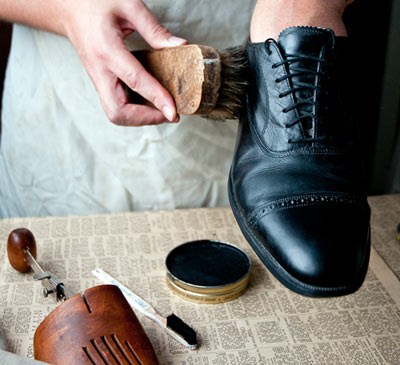 Do the little things. They matter.
Do the little things. They matter.
Shoes get polished. Frayed cuffs get hemmed. Little rips get stitched up or patched before they turn into big rips. Make it a habit to brush your suit jacket after wearing.
This doesn’t build your wardrobe or expand your style, of course, but it keeps your wardrobe from shrinking while you’re on the lookout for new pieces.
Good storage counts too — a suit or sports jacket will last a lot longer if you’ve got it on a proper wooden hanger and store it in a garment bag for long periods of disuse. Shoes should be stored with shoe trees inserted (or at least gently stuffed with rolled-up newspapers — the poor man’s shoe tree).
Read this AoM article on protecting, storing, and cleaning your clothing.
4. Find a Skilled Tailor
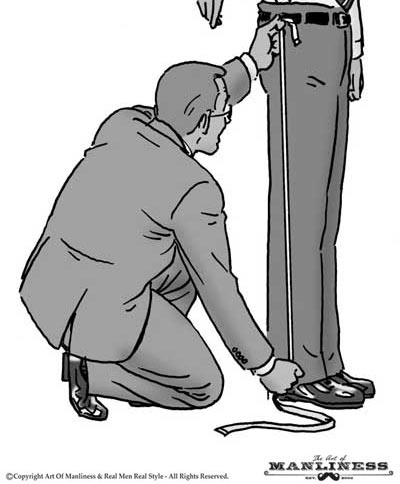
Just like shoe repairs, a professional tailor’s adjustments can turn lightly-used clothing into something resembling a brand new garment fitted just for you.
The trick is finding someone who actually specializes in adjustments, and is willing to take the time to get them truly customized. A lot of in-house tailors at ready-to-wear menswear stores aren’t really making custom adjustments even if they do take your measurements — they’re just trimming to pre-determined lengths and widths.
Look for local, independent shops and take the time to build a rapport with the tailors you find. The extra time is worth it in the long run. Here are my 7 tips for finding a great tailor.
5. Sew Your Own Buttons and Make Other Small Repairs

Minor repairs don’t take much time to learn. Anyone can become proficient at sewing buttons onto clothes in a day, and closing up small rips or applying patches isn’t that much more complicated.
The next time you need something minor fixed on a piece of clothing, look up how to do it yourself. Not all repairs will be worth the effort, but you can save a lot of money if you don’t depend on tailors’ shops for the really basic stuff.
Learn how to sew a button in 5 minutes with this AoM post.
6. Make Your Own Alterations
Taking the DIY approach one step further, a dedicated hobbyist can get nearly as good as a professional at minor clothing alterations.
As old shirts and trousers wear out, practice hemming them to different lengths. See if you can make an old shirt of yours fit a family member with a slightly different build, at least in the sleeves.
If it turns out to be something you’re good at, you can move on to more challenging adjustments like taking in darts.
Not everyone has the knack or the inclination, but someone who can take a thrift store shirt home and hem it to fit without a tailor’s help can both save money and enjoy a wider thrift-store selection.
7. Raid the Family Closets
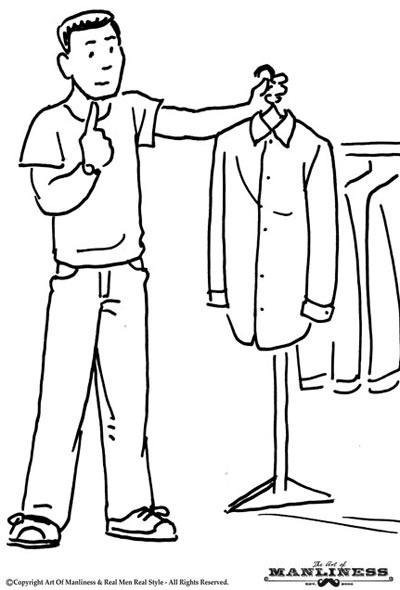 Clothes handed down from father to son are as traditional as it gets. If you don’t have a father with a suitable build (or wardrobe), check around with brothers, uncles, cousins — any male relative in about your size.
Clothes handed down from father to son are as traditional as it gets. If you don’t have a father with a suitable build (or wardrobe), check around with brothers, uncles, cousins — any male relative in about your size.
This dovetails especially nicely with the self-taught repairs and adjustments we’ve mentioned. It’s one thing to ask for charity cast-offs out of the blue, but it’s quite another when your relatives know that “fixing up old clothes” is a hobby of yours.
Of course, you do have to be careful. Once word gets out that you’re a dab hand with a needle, they’ll probably want you to start working on their clothes, too. But that’s not a bad trade if you’re getting a good supply of lightly-worn pieces for your own wardrobe.
8. Leverage Clothing Store Sales
 Not all cheap clothes have to be second-hand. Even some pricey brands have deep discounts from time to time. The trick is learning to tell real discounts from the “sale” prices that manufacturers expect to sell the majority of their goods at.
Not all cheap clothes have to be second-hand. Even some pricey brands have deep discounts from time to time. The trick is learning to tell real discounts from the “sale” prices that manufacturers expect to sell the majority of their goods at.
Red numbers and a sign saying “sale” do not a real bargain make. Clearance sections are usually better than sales sections, both online and in brick-and-mortar stores.
There are also websites that keep an eye on discounts for their members. Dappered.com is an excellent one for menswear, and there are more niche-focused sites tracking sales in just about any category of clothing you can think of.
9. Get Your Favorite Brands’ Special Offers
 A brand that you know you like is worth a little extra expense. It’s rare to find a manufacturer whose clothing always works well on your body, so when you do find one, treasure it.
A brand that you know you like is worth a little extra expense. It’s rare to find a manufacturer whose clothing always works well on your body, so when you do find one, treasure it.
Sign up for their online mailing list. You’ll end up deleting most of the offers you receive in your inbox, but there’ll be one or two every year that have a really good price on an item you really need, and those moments are worth a few seconds of clicking every few days.
If there are rewards programs associated with a brand you like (or a store that carries it), get in on those too. Be leery of any “price clubs” or similar offers that require you to spend money up front, of course, but simple reward or frequent shopper programs are almost always worth the minor added hassle (and, it must be admitted, the increase in e-mail and print advertising).
For the truly brand loyal, there may even be a point at which an associated credit card is worthwhile. Be cautious of getting into credit cards, especially if you have any history of overuse, but a smart shopper can easily use one to make only brand-specific purchases, paid off promptly, which results in savings, rewards, and a good credit history.
10. Educate Yourself & Take Action
Okay – so you’ve read this article. Have you read the many other helpful dressing and grooming posts here at AoM?
Over the last 6 years I’ve written quite a few articles for AOM on why clothing matters, specifically how to dress better, and what should be in your wardrobe.
But reading isn’t enough!
You have to apply this knowledge.
Start to prepare today. Having that interview suit ready before you need it will save you money as you have the time to apply the above principles vs. having to spend more because you’re in a rush.
Yes, you will make mistakes along the way. Use the above tips to piece together those first few outfits that make you feel like a million bucks. From there – you’ll gain the confidence and learn to truly own your image.
Watch a Video Recap
Written By Antonio Centeno
Creator of The Style System
Click here to discover how thousands of men just like you have mastered their professional presentation.



